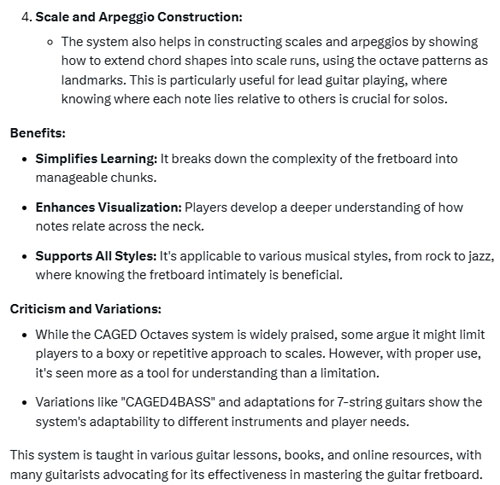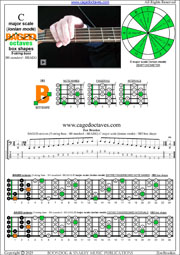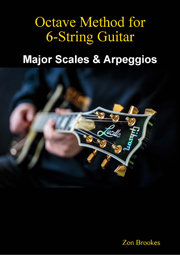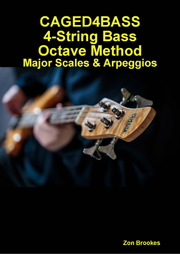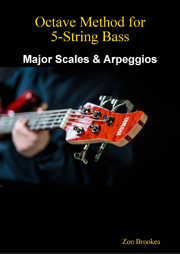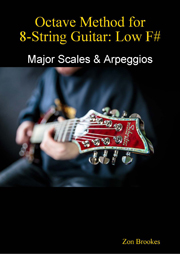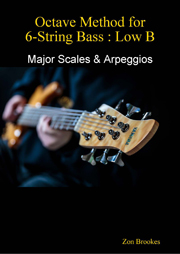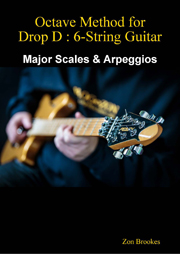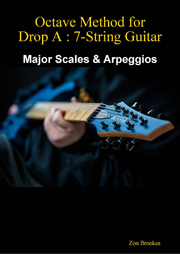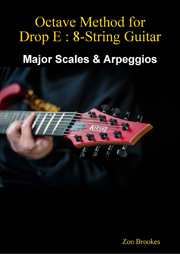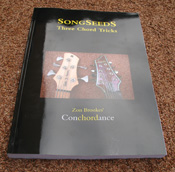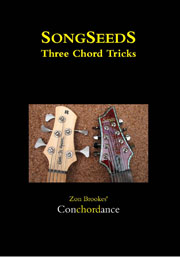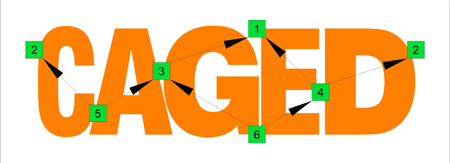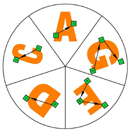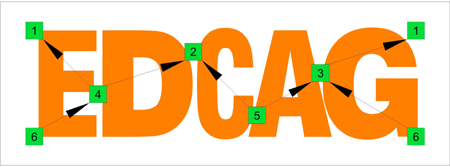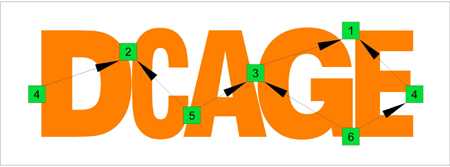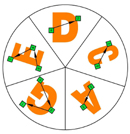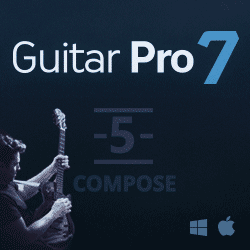|
An exciting and new fretboard navigation method for 6-string guitar based on an instrument specific modification of the familiar |
|
|
|
|
CAGED octaves - CHORD SHAPES
The standard CAGED guitar system links together the five basic open major chord shapes - C, A, G, E and D (in their barre forms) to produce a fretboard navigation system. This standard CAGED guitar system works very well when the scales, chords and arpeggios being considered are major in nature, however it tends to fall down when the scales etc. are minor in tonality (as the Cm and Gm shapes are difficult to play especially in their barre forms).
All the tabbed panels that follow show a photograph using the "players eye view" format, Guitar Pro fingerboard (with note names plotted) plus the tablature and standard music notation for the Cm, Am, Gm, Em, and Dm open chords.
- 5Cm2
- 5Am3
- 6Gm3Gm1
- 6Em4Em1
- 4Dm2
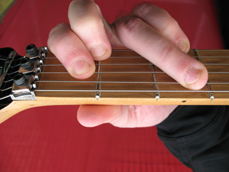

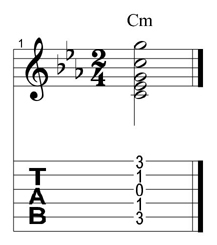
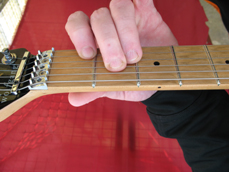


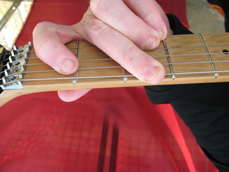

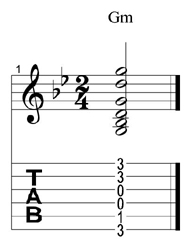


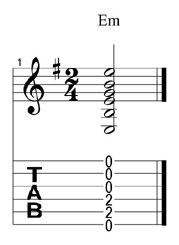
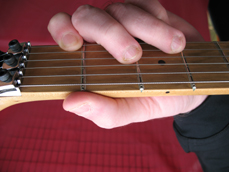


CAGED octaves - OCTAVE SHAPES
As the improvising guitarists favourite scale is the pentatonic minor this difficulty with Cm and Gm can be rather inconvenient, thus a second system has developed known as EDCAG (click-on link for details). The E shape is then referred to as Shape 1 - as this is the shape that is located at the nut for E pentatonic minor (the rock guitarist's favourite key for improvisation).
The numbered shape sytem and the CAGED octaves equivalents are as follows:-
-
Shape 1 - 6Em4Em1
Em chord shape with root notes on string numbers 6, 4 and 1
- Shape 2 - 4Dm2
Dm chord shape with root notes on string numbers 4 and 2
- Shape 3 - 5Cm2
Cm chord shape with root notes on string numbers 5 and 2
- Shape 4 - 5Am3
Am chord shape with root notes on string numbers 5 and 3
- Shape 5 - 6Gm3Gm1
Gm chord shape with root notes on string numbers 6, 3 and 1
CAGED octaves eliminates this problem as octaves are played (either singly or doubly) rather than Em, Dm, Cm, Am
and Gm shape barre chords (but chord shapes are demonstrated for completeness).
The tabbed panel below shows the five CAGED octaves shapes positioned at the nut where the shape name and sound both correspond to one another (this will not be the case when the shapes are used for other notes).
Fingers are positioned on top of the nut to illustrate where open strings are being sounded.
- 5Cm2
- 5Am3
- 6Gm3Gm1
- 6Em4Em1
- 4Dm2

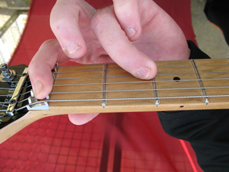
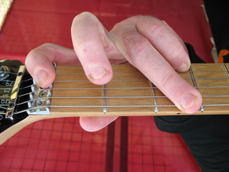


THREE NOTES PER STRING
Additionally the system has been modified for use with the three notes per string scale shapes (sweep picking) which produce seven shapes known memorably as Patterns I, II, III, IV, V, VI and VII.
These shapes cannot be classified with the conventional CAGED guitar system as they are hybrid shapes that sit across more than one letter of the word CAGED at a time, however the CAGED octaves method eliminates this problem.
The roman numeral shape names and the CAGED octaves equivalents are listed for the MAJOR SCALE in the table that follows:-
Shape No. |
CAGED octaves |
I |
6E4D2 |
II |
4D2 |
III |
5C2 |
IV |
5A3 |
V |
5A3G1 |
VI |
6G3G1 |
VII |
6E4E1 |
|
|
The roman numeral shape names and the CAGED octaves equivalents are listed for the NATURAL MINOR SCALE in the table that follows:-
Shape No. |
CAGED octaves |
I |
6Em4Dm2 |
II |
4Dm2 |
III |
5Cm2 |
IV |
5Am3 |
V |
5Am3Gm1 |
VI |
6Gm3Gm1 |
VII |
6Em4Em1 |
|
|
These three notes per string hybrid BOX SHAPES have been explored in detail for the following scales:-
- C major scale box shapes- BLOGoZON No.278
- C major arpeggio box shapes- BLOGoZON No.280
- C major arpeggio box shapes- BLOGoZON No.280
- A natural minor scale box shapes - BLOGoZON No.283
- A minor arpeggio box shapes - BLOGoZON No.284
- A minor arpeggio box shapes - BLOGoZON No.284
- A blues scale box shapes - BLOGoZON No.27
- A harmonic minor scale box shapes - BLOGoZON No.25
- E natural minor scale box shapes - BLOGoZON No.52
AGEDC - GEDCA - EDCAG - DCAGE
As illustrated by the CAGED octaves circles shown above the word CAGED should really be represented in a circular fashion - with the letter that points north being the starting shape located at the guitar's nut. The examples on the remainder of the website are in the easiest of keys - A minor; hence the CAGED octaves letter order is AGEDC.
Here is a very brief explanation of the CAGED octaves methodology :–
- The large orange letters represent the underlying chord shape (as they sound at the nut) i.e. C, A, G, E and D.
- The green boxes are the root notes.
- The numbers in the green boxes represent the string numbers 1 to 6.
- The arrows point away from the root note (interval number 1) towards the octave note (interval number 8)
Seven single octave shapes are produced:-
- 5Cm2
Cm chord shape with root notes on string numbers 5 and 2
- 5Am3
Am chord shape with root notes on string numbers 5 and 3
- 6Gm3
Gm partial chord shape with root notes on string numbers 6 and 3
- 3Gm1
Gm partial chord shape with root notes on string numbers 3 and 1
- 6Em4
Em partial chord shape with root notes on string numbers 6 and 4
- 4Em1
Em partial chord shape with root notes on string numbers 4 and 1
- 4Dm2
Dm chord shape with root notes on string numbers 4 and 2
Plus two double octave shapes:-
- 6Gm3Gm1
Gm chord shape with root notes on string numbers 6, 3 and 1
- 6Em4Em1
Em chord shape with root notes on string numbers 6, 4 and 1
Click on a link below to view the detailed information:-
The lower case “m” indicates that the chord/scale/arpeggio is minor rather than major
Enjoy the playing
Zon Brookes

